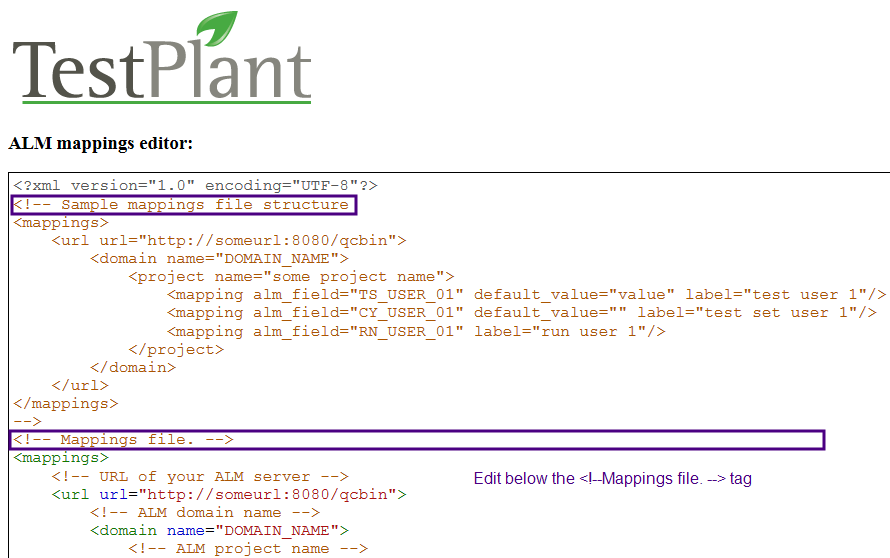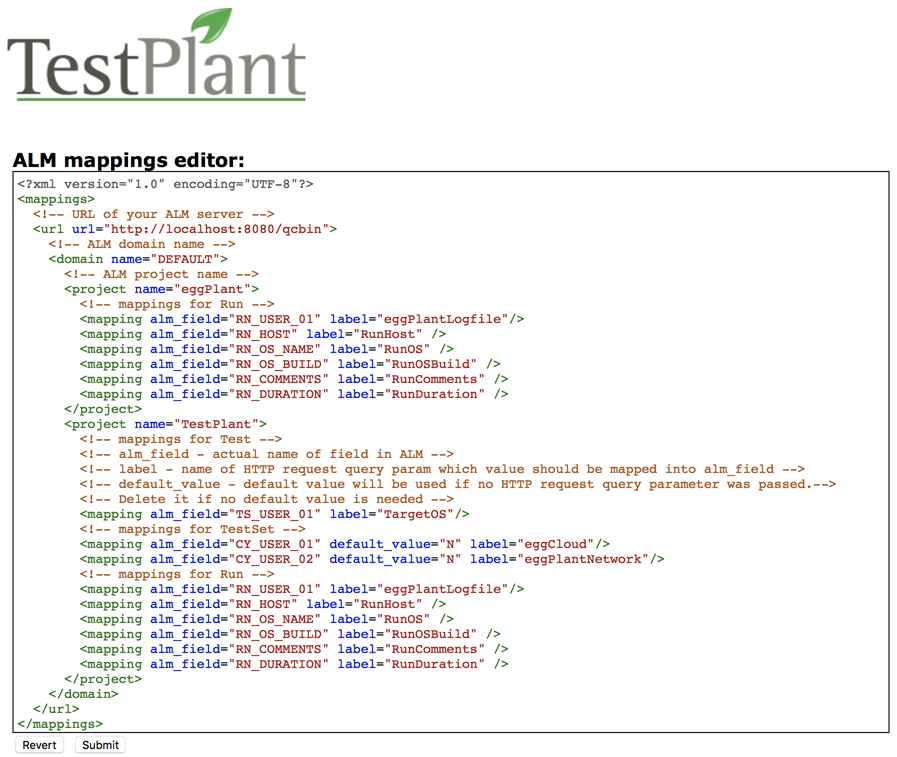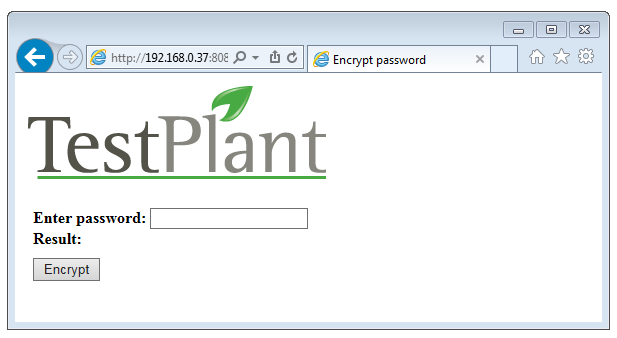Configuring Eggplant Integrations for HPE ALM
Configuring Eggplant Integrations for HPE ALM to work with your HPE Application Lifecycle Management (ALM) system consists of the following two tasks:
Explanations of each task follow.
Configuring Mappings for HPE ALM
Part of configuring Eggplant Integrations for HPE ALM is providing information about your HPE ALM server and projects by creating and modifying mappings that include values for your HPE ALM. The Eggplant Integrations for HPE ALM includes a mappings editor you can use to modify and create these mappings.
Instructions for editing the mappings are provided below. Before you do this editing, you need to know about the different types of mappings.
Types of Mappings
Use the following types of mappings to create or modify your configuration using your Eggplant Integrations for HPE ALM mappings editor:
- Connection and project mappings (required for Eggplant Integrations for HPE ALM): These mappings are for your HPE ALM connection, domain and project information.
- Entity mappings: The Run, Test, and Test Set "entity" mappings are for test entities in HPE ALM. HPE ALM divides its projects into categories, which are called "entities." HPE ALM provides Run, Test, and Test Set entities. The Eggplant Integrations for HPE ALM can capture and upload this information about your tests to HPE ALM, when you create these mappings.
For information about these and other HPE ALM entities, see the HPE ALM Administrator's Guide. Instructions for creating entity mappings are provided below in Formatting Mappings for HPE ALM Entities.
Formatting Mappings for HPE ALM Entities
If you decide to use any of the supported entities, you need to create mappings for them using the Eggplant Integrations for HPE ALM mappings editor. An example of the format and explanations of the elements you need to use are provided below. For example, if you want to use the Run entity fields: Host, Operating System, OS Build Number, Comments, and Duration. You need to add the following mappings in the <!-- Mappings file --> section of the mappings editor, below the <!--mappings for Run --> section:
The elements you use in a mapping are as follows:
- mapping alm_field= The name of the actual field in HPE ALM.
- label= The name of the HTTP request query parameter value that should be mapped to the alm_field.
- default_value= An optional default value you can provide (not shown above).
Continue to the next section for information about using the Mappings editor.
Step by Step: Using the Mappings Editor to Configure Mappings
The following steps describe how to use the Eggplant Integrations for HPE ALM Mappings editor to configure and create your HPE ALM mappings.
- Display the Eggplant Integrations for HPE ALM Home page as described in Displaying the Eggplant Integrations for HPE ALM Home Page.

- On the Home page, click the Configure ALM mappings link. The ALM mappings editor page appears, showing you the mappings file contents.

- Notice that the top of the page is a sample of the mappings file structure. Don’t edit this section!
- Scroll down to the <!-- Mappings file --> section. You want to modify the mappings below it:

To configure multiple projects when configuring the <!-- Mappings file --> section, use the following approach as a guideline:

- Provide the connection information for your HPE ALM server (required) under <!-- URL of your ALM server -->, in the <url url="http://someurl:8080/qcbin"> element , by replacing someurl:8080 with the hostname or IP address and port for your HPE ALM server.
- Specify your HPE ALM domain name (required) in the <domain name="DOMAIN_NAME"> element by replacing DOMAIN_NAME with your HPE ALM domain name. If you plan to upload tests and results to more than one domain, you need to copy and paste the domain mapping for each domain and modify the domain name for each accordingly. The domain mapping begins with the <domain name="DOMAIN_NAME"> xml tag and ends with </domain>.
- Specify your project name (required) in the <project name="some project name”> element by replacing some project name with the name of the project you want in your HPE ALM. If you plan to upload tests and results to more than one project, you need to copy and paste the project mapping for each domain and modify the project name for each accordingly. The project mapping begins with the <project name="some project name"> xml tag and ends with </project>. Be sure you add your projects within the correct domain mapping.
- Determine if you are using any of the supported HPE ALM entity fields in your test organization. If you are and you want to use them in this integration, create mappings for the fields within the correct project mapping as described in Formatting Mappings for HPE ALM Entities above.
- If you created mappings to any HPE ALM entity fields, and want to view data using labels for these fields, append any labels on which you want to search to the URL discussed in previous steps. For example, if you added label="custom run field" to a custom field created in the Run table of the database, append "custom run field":"myinfo" to the URL.
- When you finish creating and modifying mappings, click Submit below the ALM mappings editor window. The pane below will say OK if the information you provide is valid, or display an error message you can use to identify and resolve any issues.
Generating an Encrypted Password
The setup scripts in example suites are required for integrating Eggplant Functional with the HPE ALM. One of the configuration parameters by these scripts is an encrypted password for your HPE ALM. You must provide an encrypted password for these scripts. The Eggplant Integrations for HPE ALM provides a password encryption tool you can use to encrypt your HPE ALM password.
Follow the steps below to use the Eggplant Integrations password encryption tool:
- Display the Eggplant Integrations for HPE ALM home page as described in Displaying the Eggplant Integrations HPE ALM Home Page, which is in Eggplant Integrations for HPE ALM Administration.
- Click the Encrypt password link. The Encrypt password page opens.
- Enter the password for the HPE ALM user you want the Eggplant Integrations to use to log in to HPE ALM, then click Encrypt. Your encrypted password appears.
- Save this encrypted password. Provide this encrypted password in the setup scripts as described in Integrating Eggplant Functional with HPE ALM.

